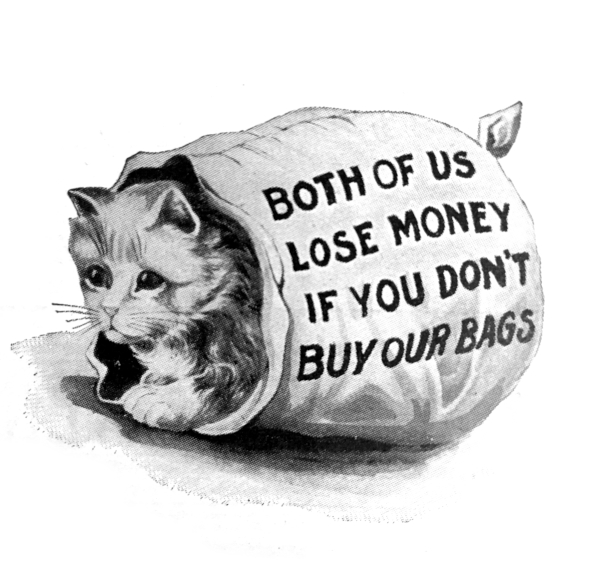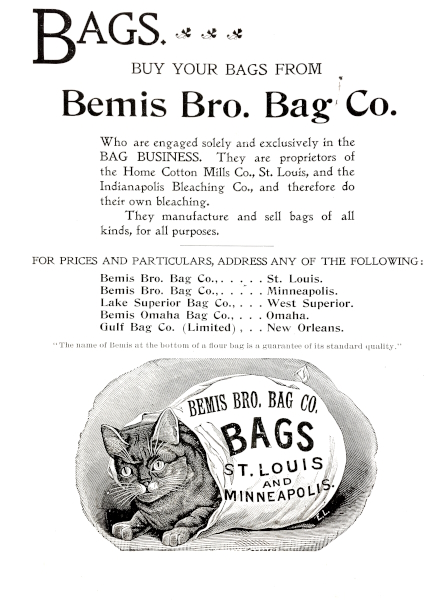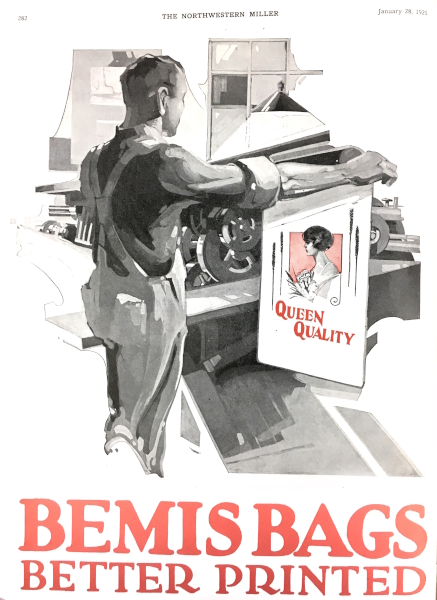 |
I doubt that many people have ever heard the name Judson Moss Bemis or his brother Stephen, who would introduce the ‘cat in the bag’ image that would be the signature logo for their company.
The company of J M Bemis & Co. started out in 1858 with Judson determined to launch a permanent business enterprise of his own. He contacted his cousin Simeon Farwell, the owner of a modestly successful bag factory. This gave him the idea to enter the industry himself with St Louis as his headquarters. So at the age of 25 Judson Bemis launched J M Bemis & Company, Bag Manufacturers with an investment of $4,000.
The factory he opened produced the first commercially machine sewn colour printed textile bags in the US, bags that previously had been hand sewn and hand stencilled. Bemis guaranteed all his bags against ripping, and soon sent circulars to most of the city’s flour millers. The staff of four was soon filling orders and supplying expensive, custom printed Bemis bags which would save millers the time consuming messy task of stencilling, and also had appeal to the average consumer, long accustomed to buying flour in cumbersome wooden barrels. The office and factory in St Louis, Missouri proved a very fortunate choice, for it had become the centre of trade for points north and south along the Mississippi river, as well as from tributary traffic from the Missouri and Illinois Rivers.
Stephen, the son of Judson Moss would take charge of the St Louis plant in 1885 and it was said that he introduced the ‘cat in the bag’ logo. The first cat was called ‘Biddy’, and was a common sight at the St Louis Bemis Bag company factory as the champion mouser. It is said that she was brought into the factory by her owner, Miss Annie Fyfe who was the lady in charge of the cotton department in 1882. One day Biddy was exploring an empty bag on the shop floor and when she emerged she struck her famous pose, which was seen by Stephen Bemis, inspiring him to use the cat as the company’s trade mark. |
 |
Biddy first appeared on the advertisement for the company in the May 30th 1884 issue of the Northwestern Miller. Although the cat image changed over the years it was used for over almost 70 years until 1950.
By the early 1880s with still the one factory, Bemis were the second most successful manufacturer of flour bags and would become the number one in the world by the close of the 19th century.
As the business grew in 1881, Bemis opened additional offices in Boston and Minneapolis. Significantly, Minneapolis would become the headquarters in modern times for the firm. The evolution in agriculture and advent of railroad networks would transform the milling trade in the city, which would become the ‘Mill City’ with the rise of Pillsbury, General Mills and others.
Further bag factories were established in Omaha 1887, New Orleans 1891, Wisconsin 1896, San Francisco 1897, Indianapolis and Memphis 1900, Kansas City 1903, Seattle 1905, and Houston and Winnipeg in 1906. In addition to this the firm began operating a bleachery in Indianapolis in 1896 for the finished bags and also opened a cotton mill near Jackson, Tennessee in 1900. The company-sponsored village that arose around the mill was eventually dubbed Bemis. In 1870 the Home Cotton Mills was established, and this would be the last acquisition by Bemis in 1902. |
 |
The company gained from its entry into the sale of raw cotton. Profits from this side-line business helped them to focus on burlap production. Firstly second-hand ‘gunny’ sacks were used that had shipped linseed from Calcutta, followed by original burlap sacks made from imported jute fibre.
Burlap, known as hessian in the UK, is a dense woven fabric created from jute, sissal or hemp, a coarse stranded yet eco-friendly thread. Burlap is a strong, versatile material that is cheap yet robust and easy to work. It was first imported from India around the beginning of the 19th Century and used in packaging. Gunny sacks were also made from hessian.
By 1900 Bemis Bro. Bag Company was operating eight textile bag factories across the US, making burlap and cotton bags for grain, flour, feed and other products. They also ran two cotton mills and became the world’s largest importer of burlap from India. In 1913, they built a paper mill in Peoria, Illinois, expanding to take in paper products. |
 |
In 1921 Judson Moss Bemis passed away and was succeeded first by his son, Albert Farwell Bemis, then by his nephew J S Bemis and later his grandson F G Bemis.
Bemis still continued producing cotton and burlap bags into the 1950s and 60s, but they were putting more emphasis on paper products. In 1964 the name changed again from Bemis Bros. Bag Co to the Bemis Company Inc. and sadly this was the year in which the ‘cat in the bag’ ceased to be used. The new logo would be a “b” shaped bar with an oval.
1980 saw the selling off of their textile mills, and in 1990’s the purchase of Milprint and Princeton Packaging confirmed them as the No.1 in bread packaging. The Bemis cotton mill at Jackson Tennessee was demolished on Monday July 31st 2017. Bemis transferred its superiority in the milling industry into success in the complex food markets of today where it continues to be a major producer of flexible packaging.
The adverts shown here are reproduced from the Northwestern Miller journal. The Mills Archive holds the most complete set of the Northwestern Miller, from 1897 to 1973 with just a few issues missing. |